As an Amazon Associate KitchenwareSets.com earns from qualifying purchases.
11 Cottage Core Kitchen Ideas for Cozy Timeless Charm
Do you ever scroll through Pinterest and find yourself pausing on kitchens that feel less like a sterile cooking space and more like the heart of a cozy, storybook home? These are rooms filled with warm light, natural textures, and a lived-in charm that seems to whisper tales of freshly baked bread and simmering pots of soup. If you’re yearning for a sanctuary that blends rustic charm with modern comfort, you’ve likely fallen for the cottagecore aesthetic.
The great news is that this nostalgic, nature-inspired trend is more than just a fleeting style; it’s a way of creating a space that feels deeply personal and inviting. In this guide, we’ll walk you through 11 actionable cottage core kitchen ideas that will help you transform your space into the warm, charming haven you’ve been dreaming of.
A cottagecore kitchen is a design style that transforms your cooking space into a cozy, rustic retreat inspired by rural life. It emphasizes natural materials like wood, earthy color palettes, vintage finds, and handmade decor to create a warm, inviting, and lived-in atmosphere.
What Makes a Kitchen “Cottagecore”?
Key elements of a cottagecore kitchen include soft, earthy colors (sage green, creamy white), natural wood tones (reclaimed wood, butcher block), quaint furniture (farmhouse tables, open shelving), and charming decor like floral patterns, vintage finds, and fresh greenery. These components work together to create a space that feels both nostalgic and deeply connected to nature. The core philosophy is about celebrating simplicity, comfort, and the beauty of imperfections.
Here are the foundational pillars of the style:
- Earthy & Natural Color Palettes: Think of colors you’d find in a meadow or a forest—soft greens, creamy whites, muted blues, and warm beiges form the backdrop.
- The Central Role of Wood Tones: Wood is essential for adding warmth. This can be through butcher block countertops, a sturdy farmhouse table, or rustic open shelving.
- Quaint & Cozy Furniture Choices: Furniture with history and character is preferred over sleek, modern pieces. Mismatched chairs, vintage hutches, and simple benches are staples.
- Personal, Handcrafted Decorative Elements: This is where the kitchen’s personality shines through. Displayed pottery, vintage textiles, woven baskets, and fresh herbs make the space feel uniquely yours.
11 Cottage Core Kitchen Ideas for a Cozy, Timeless Space
Ready to turn your kitchen into a cottagecore haven? These 11 distinct and achievable ideas will guide you, whether you’re planning a full renovation or just looking for simple updates. From easy DIY projects to smart decor choices, you’ll find inspiration to create a kitchen that is both beautiful and full of soul.
1. Embrace an Earthy Palette with Soft Sage Green
The fastest way to establish a cottagecore vibe is with color, and painting your kitchen cabinets a soft sage green instantly creates a serene, nature-inspired foundation. This gentle hue pairs beautifully with creamy whites, wood tones, and brass hardware, setting a calm and inviting mood.
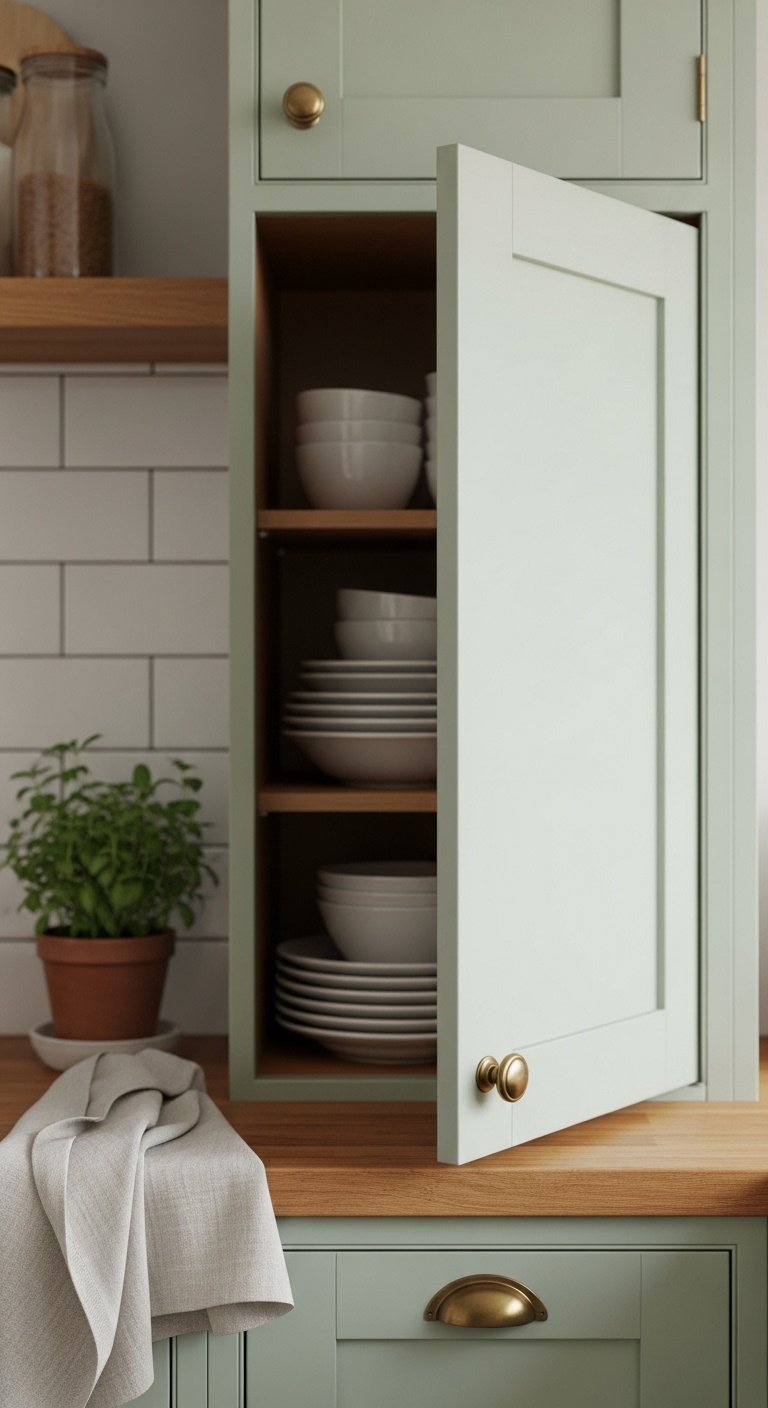
- Materials Needed: Degreaser/cleaner, sandpaper (120-grit), primer, soft sage green cabinet paint (satin or eggshell finish), paint brushes/rollers, painter’s tape, new hardware (optional, brass or copper).
- Step-by-Step Directions:
- Remove cabinet doors and hardware. Thoroughly clean all surfaces with a degreaser.
- Lightly sand all surfaces to be painted to help the primer adhere. Wipe away dust.
- Apply a thin, even coat of primer and let it dry completely.
- Apply 2-3 coats of your soft sage green paint, allowing for adequate dry time between coats.
- Once fully cured, re-install the doors with your original or new hardware.
Pro-Tip: For a moodier, “dark cottagecore” look, consider a deep forest green or rich, dark wood tone on lower cabinets while keeping upper walls or shelves a creamy white for balance.
Pin this color inspiration for your future kitchen makeover!
2. Install Open Shelving to Display Your Treasures
To achieve a lived-in, personalized look, replace some upper cabinets with rustic open shelving made from reclaimed wood. This not only makes a small kitchen feel more airy and open but also provides the perfect stage to display your favorite mismatched dishware, vintage glassware, and handcrafted pottery.
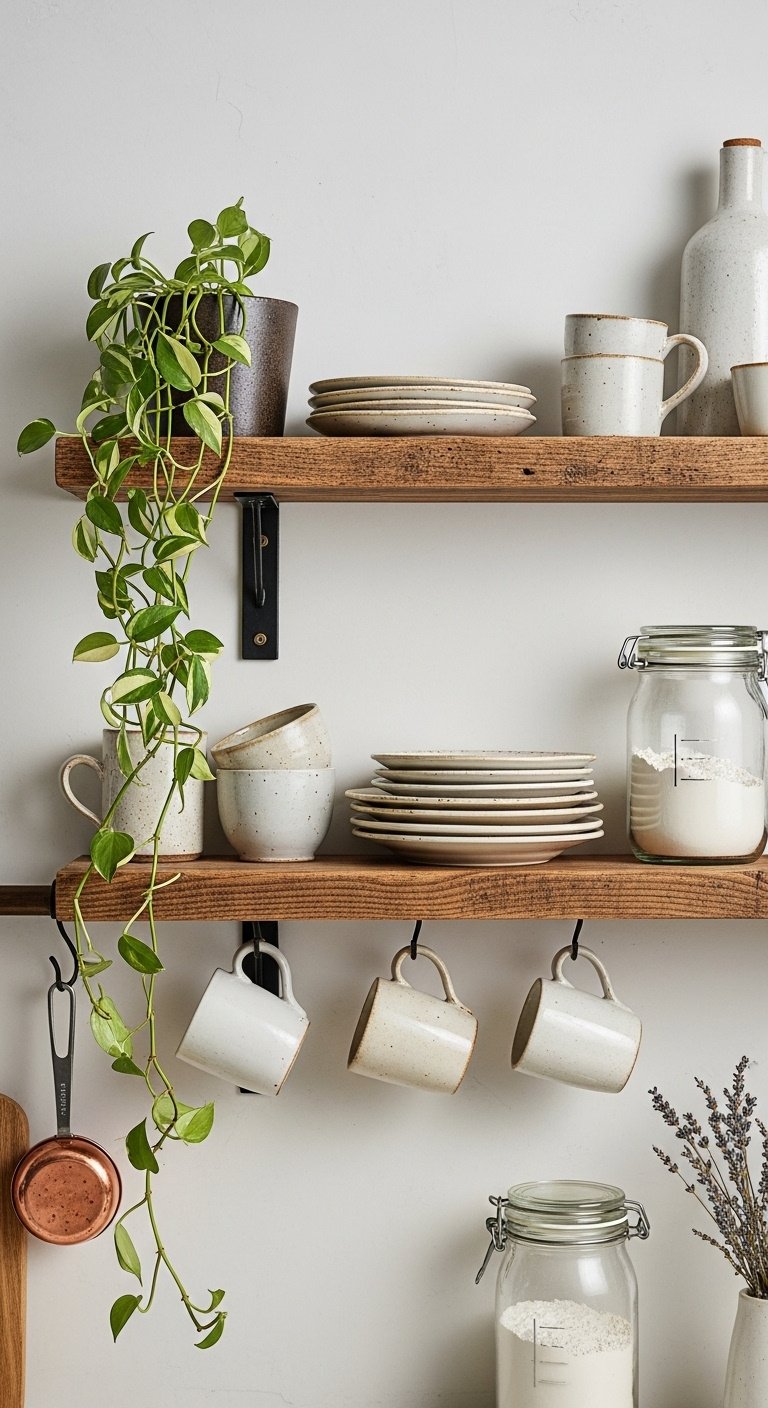
- Materials Needed: Reclaimed wood planks or pine boards, shelf brackets (wrought iron or brass), level, stud finder, drill, screws, wall anchors.
- Step-by-Step Directions:
- Decide on the placement of your shelves. Use a stud finder to locate wall studs for secure mounting. Mark the locations.
- If you can’t hit a stud, use appropriate wall anchors.
- Use a level to mark a straight line for your brackets. Drill pilot holes and attach the brackets to the wall.
- Place your wood plank on the brackets and secure it from underneath with small screws.
- Style your shelves with your favorite mugs, plates, dried herbs, and small plants.
Lesson Learned: Don’t overcrowd the shelves! The key to cottagecore shelving is a curated, lived-in look, not a cluttered one. Leave some breathing room between items.
Love this look? Save it to your ‘Dream Kitchen’ Pinterest board!
3. Add Whimsical Charm with a DIY Sink Skirt
A simple yet incredibly effective cottagecore touch is to add a fabric sink skirt to conceal under-sink plumbing and storage. This budget-friendly DIY project introduces softness, pattern, and a dose of old-world charm, instantly making your kitchen feel cozier and more whimsical.
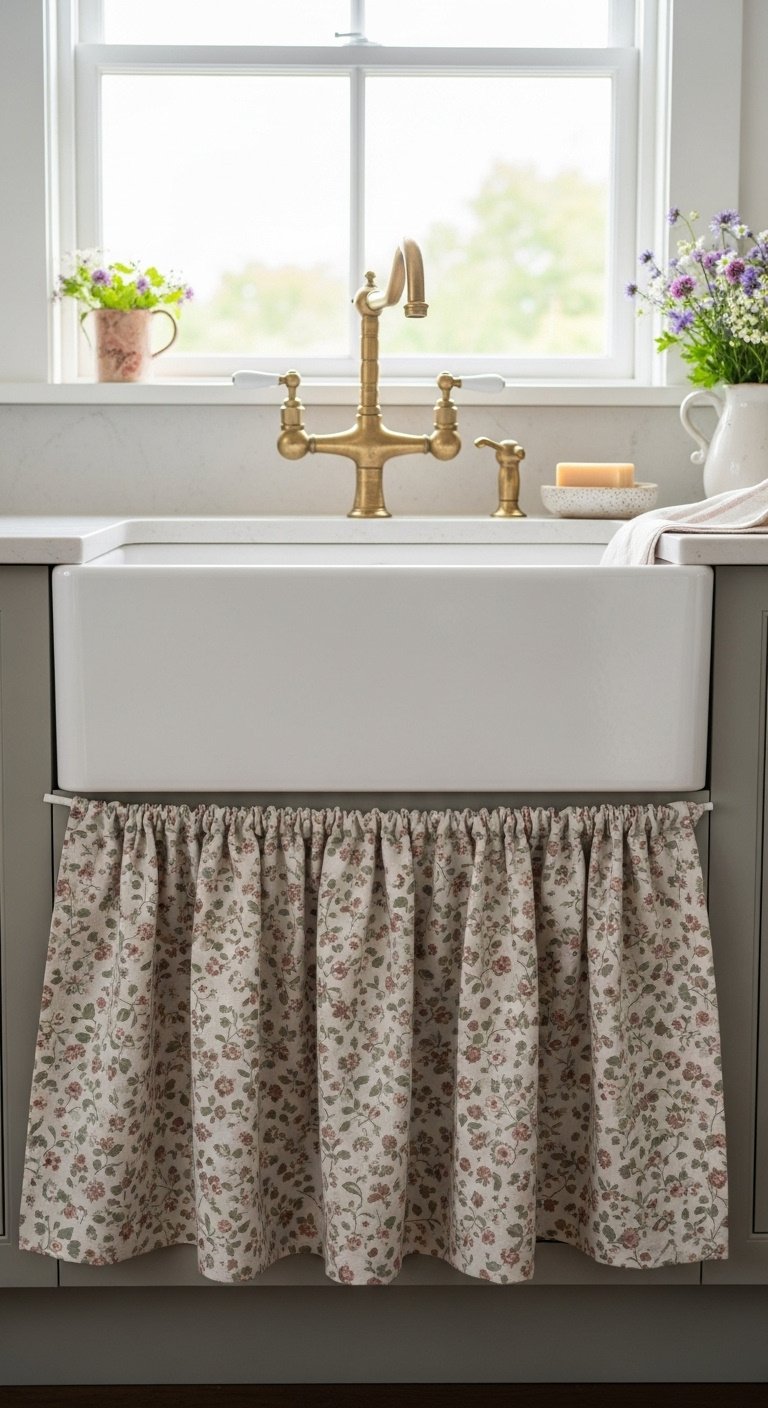
- Materials Needed: Fabric of your choice (gingham or floral print linen), measuring tape, scissors, iron, sewing machine or hemming tape, tension rod or adhesive velcro strips.
- Step-by-Step Directions:
- Measure the width and height of the area under your sink you want to cover.
- Cut your fabric to be 1.5 times the width (for a gathered look) and 2 inches longer than the height (for hems).
- Hem all four sides of the fabric. Create a pocket along the top edge large enough for your tension rod to slide through.
- Iron the finished skirt, slide it onto the tension rod, and install it snugly under your sink. Alternatively, attach it with adhesive velcro.
Pro-Tip: Check thrift stores for vintage tablecloths or curtains that can be repurposed into a unique, one-of-a-kind sink skirt for just a few dollars.
Share this charming DIY project with a friend!
4. Bring in Natural Texture with Woven Baskets
To add instant warmth and rustic character, use woven baskets made of wicker, rattan, or seagrass for both storage and decoration. These natural elements provide beautiful texture and are incredibly practical for organizing everything from root vegetables and fresh bread to linens and utensils.
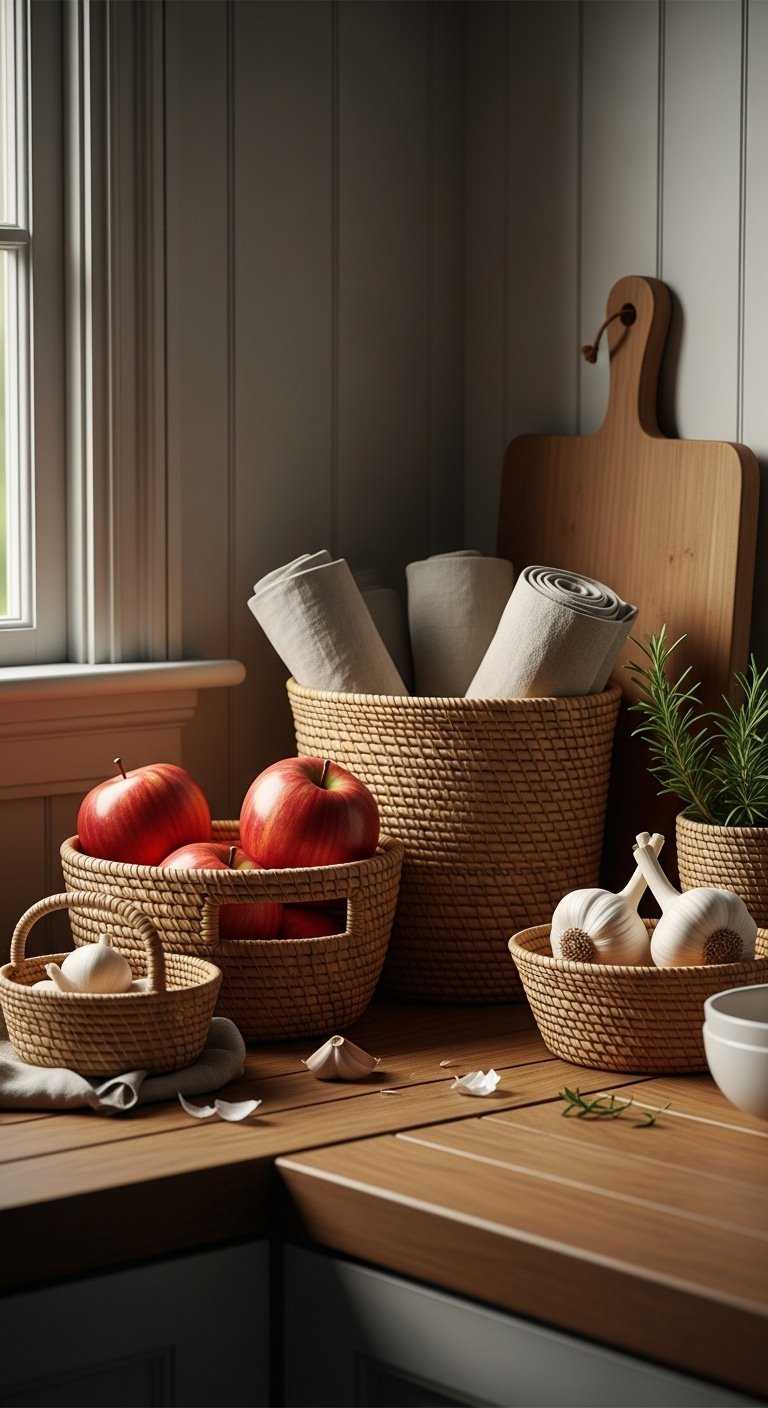
- Materials Needed: A collection of woven baskets in various shapes and sizes.
- Step-by-Step Directions:
- Identify your storage needs. What needs a home? Tea towels, fresh produce, bread, or cooking utensils?
- Assign baskets to specific tasks. Use a larger basket on the floor for potatoes and onions, a flat basket on the counter for fresh bread, and smaller baskets on open shelves for garlic or dish towels.
- Hang a basket on the wall to create a vertical storage spot for mail or fresh flowers.
- Don’t be afraid to mix and match different weave styles for a collected, eclectic look.
Lesson Learned: Baskets are not just for storage. A beautiful, empty basket hung on the wall can serve as a simple, textural piece of art that adds warmth to a blank space.
Get organized! Pin these beautiful storage solutions.
5. Infuse Character with a Sturdy Farmhouse Table
The heart of a cottage kitchen is a place to gather, so make a sturdy, wooden farmhouse table the focal point of your space. Whether it’s a new purchase or a thrifted find, a farmhouse table provides a central spot for meals, conversations, and everyday activities, radiating warmth and welcome.
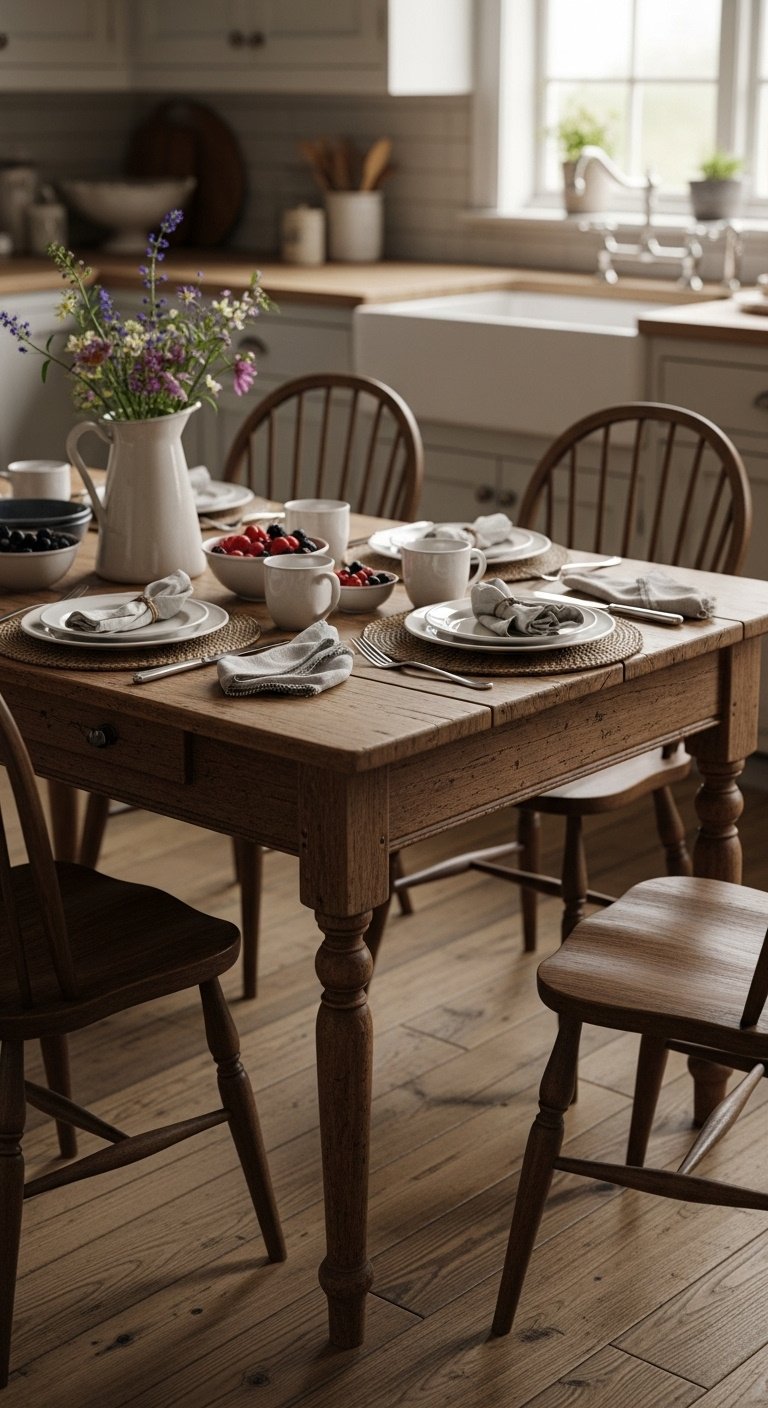
- Materials Needed: A farmhouse table (new or thrifted), sandpaper (optional), chalk paint or wax (optional), mismatched wooden chairs.
- Step-by-Step Directions:
- Source your table. Look at flea markets, antique stores, or online marketplaces for a sturdy, solid wood table with character.
- Decide on the finish. Leave it as-is for a naturally distressed look, or give it a light sanding and a coat of chalk paint on the legs for a fresh feel. A simple wax can also enhance the natural wood grain.
- Pair the table with mismatched chairs. Collect Windsor chairs, simple ladder-backs, or even a small bench to create an informal and inviting seating arrangement.
- Center the table in your kitchen or breakfast nook to establish it as the primary gathering spot.
Pro-Tip: Don’t worry about perfection. Scratches, dings, and a slightly worn finish on a farmhouse table add to its history and character, which is the essence of the cottagecore aesthetic.
Dreaming of family gatherings here? Save this to your ‘Home Goals’ board!
6. Add Warmth and Function with Butcher Block Countertops
For a surface that is both beautiful and practical, choose butcher block countertops to add immense warmth and rustic charm. Unlike cold stone, wood countertops feel inviting and develop a lovely patina over time, perfectly embodying the well-loved, functional nature of a cottage kitchen.
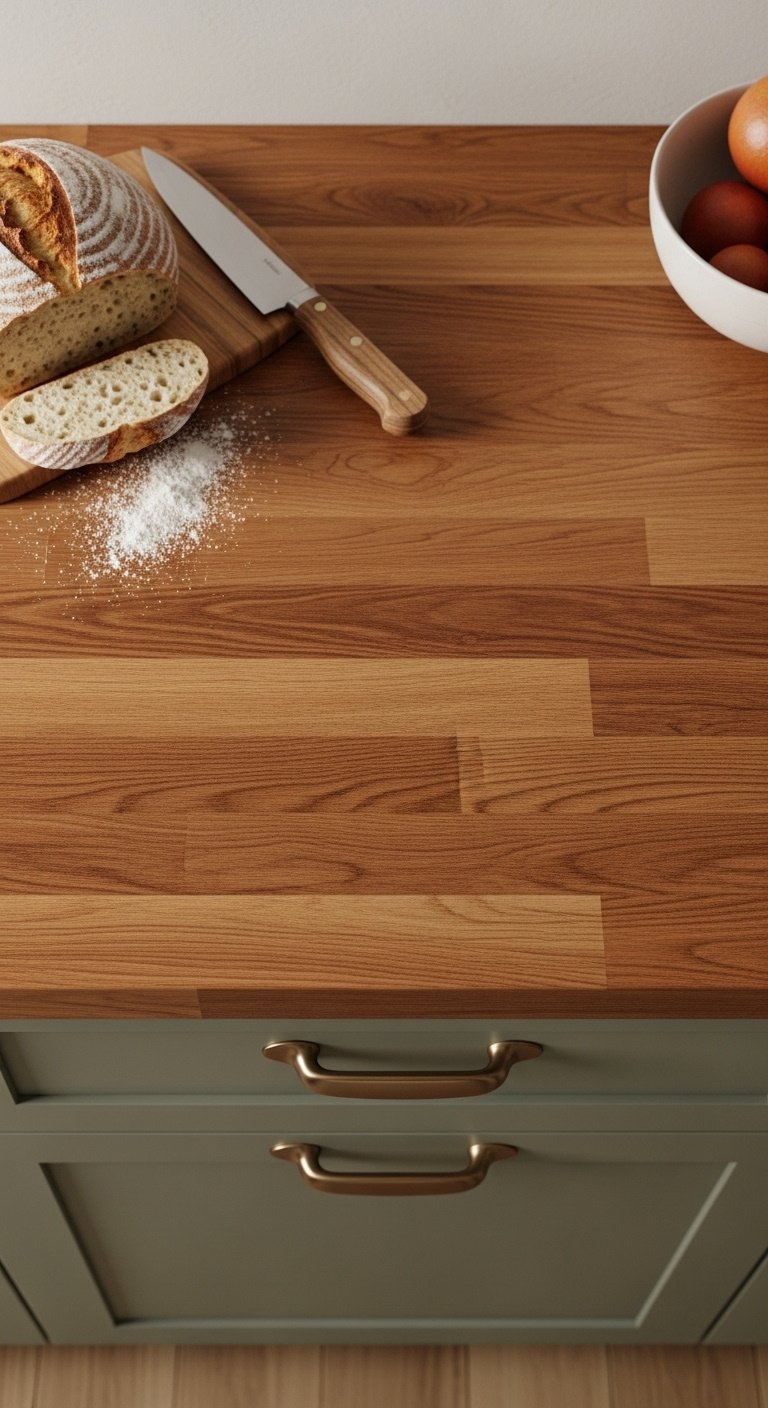
- Materials Needed: Butcher block slab, measuring tape, circular saw, sandpaper (multiple grits), food-safe wood oil or conditioner, clean cloths.
- Step-by-Step Directions:
- Carefully measure your existing countertops or cabinet base and cut the butcher block to size, making sure to account for sink or appliance cutouts.
- Sand the entire surface of the butcher block, starting with a medium grit and moving to a fine grit for a smooth finish.
- Wipe away all dust with a tack cloth.
- Apply a generous coat of food-safe mineral oil or a specialized butcher block conditioner. Let it soak in for at least 20-30 minutes, then wipe away the excess.
- Repeat the oiling process several times before installation to fully seal the wood. Re-oil every few months to maintain its beauty and durability.
Lesson Learned: Butcher block is beautiful but requires maintenance. Always use cutting boards to avoid deep scratches and wipe up spills promptly, especially liquids like red wine or coffee, to prevent stains.
Pin this beautiful countertop idea for your renovation plans!
7. Bring Nature Indoors with a Windowsill Herb Garden
A core tenet of cottagecore is the connection to nature, so cultivate a simple herb garden on your kitchen windowsill. Having fresh basil, rosemary, and mint in charming terracotta pots is not only practical for cooking but also adds life, color, and a beautiful natural aroma to your space.
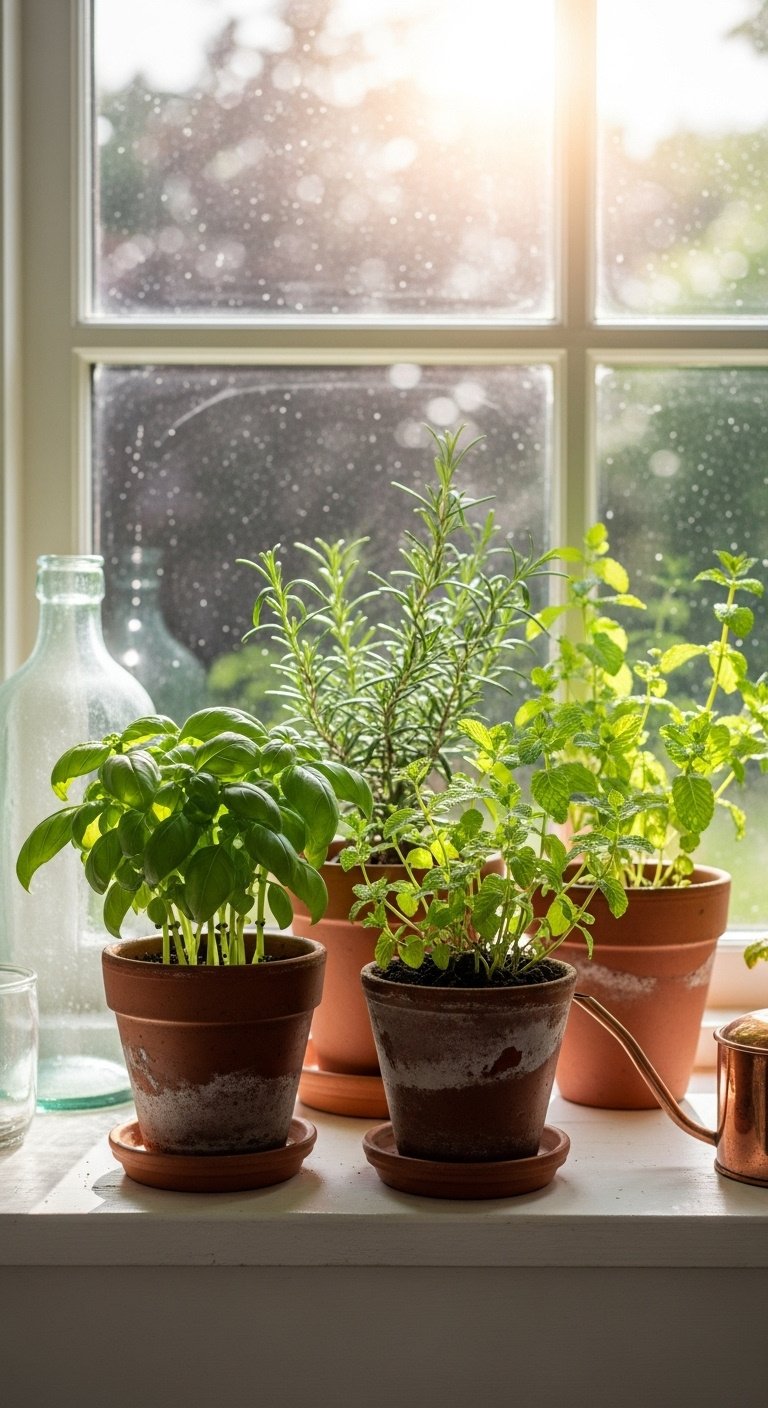
- Materials Needed: Several small terracotta pots, potting soil, herb seedlings (e.g., basil, parsley, rosemary, thyme), a sunny windowsill, a small watering can.
- Step-by-Step Directions:
- Fill each terracotta pot with potting soil, leaving a small amount of space at the top.
- Gently remove an herb seedling from its container, loosen the roots slightly, and plant it in the new pot. Add more soil around it and pat down gently.
- Repeat for all your chosen herbs.
- Give them a good initial watering and place them on your sunniest kitchen windowsill.
- Water regularly, and enjoy having fresh herbs on hand for cooking!
Pro-Tip: Mismatched pots add to the charm. Scour thrift stores for unique, small ceramic or terracotta pots to give your herb garden extra character.
Add a touch of green! Save this fresh idea.
8. Layer in Cozy, Vintage-Inspired Lighting
To create that essential warm and inviting glow, layer your kitchen with multiple vintage-inspired light sources. Move beyond a single overhead fixture and incorporate wall sconces, a central pendant light with character, and even a small countertop lamp to build a cozy, whimsical ambiance.

- Materials Needed: A mix of lighting fixtures (e.g., one central pendant, wall sconces, a small countertop lamp), warm-temperature LED bulbs (2700K).
- Step-by-Step Directions:
- Task Lighting: Start with a central fixture over the island or dining table. A vintage-style pendant with a glass shade or wrought iron details works perfectly.
- Ambient Lighting: Add wall sconces on either side of a window or open shelving. This adds a soft, diffused glow.
- Accent Lighting: Place a small, charming lamp with a fabric shade on a section of the countertop. This is the secret to creating a truly cozy, lived-in feel in the evenings.
- Use warm-temperature bulbs in all fixtures to avoid harsh, sterile light.
Pro-Tip: Install dimmer switches on your main lights. This gives you complete control over the ambiance, allowing you to transition from bright and functional for cooking to soft and moody for a quiet evening.
Light up your life! Pin this cozy lighting tip.
9. Mix and Match Metals for an Eclectic Charm
A cottagecore kitchen shouldn’t feel perfectly matched; it should feel collected over time. Embrace an eclectic look by mixing different warm-toned metals for your hardware, faucet, and decor. Combining aged brass, oil-rubbed bronze, and polished copper adds depth, character, and a sense of history.
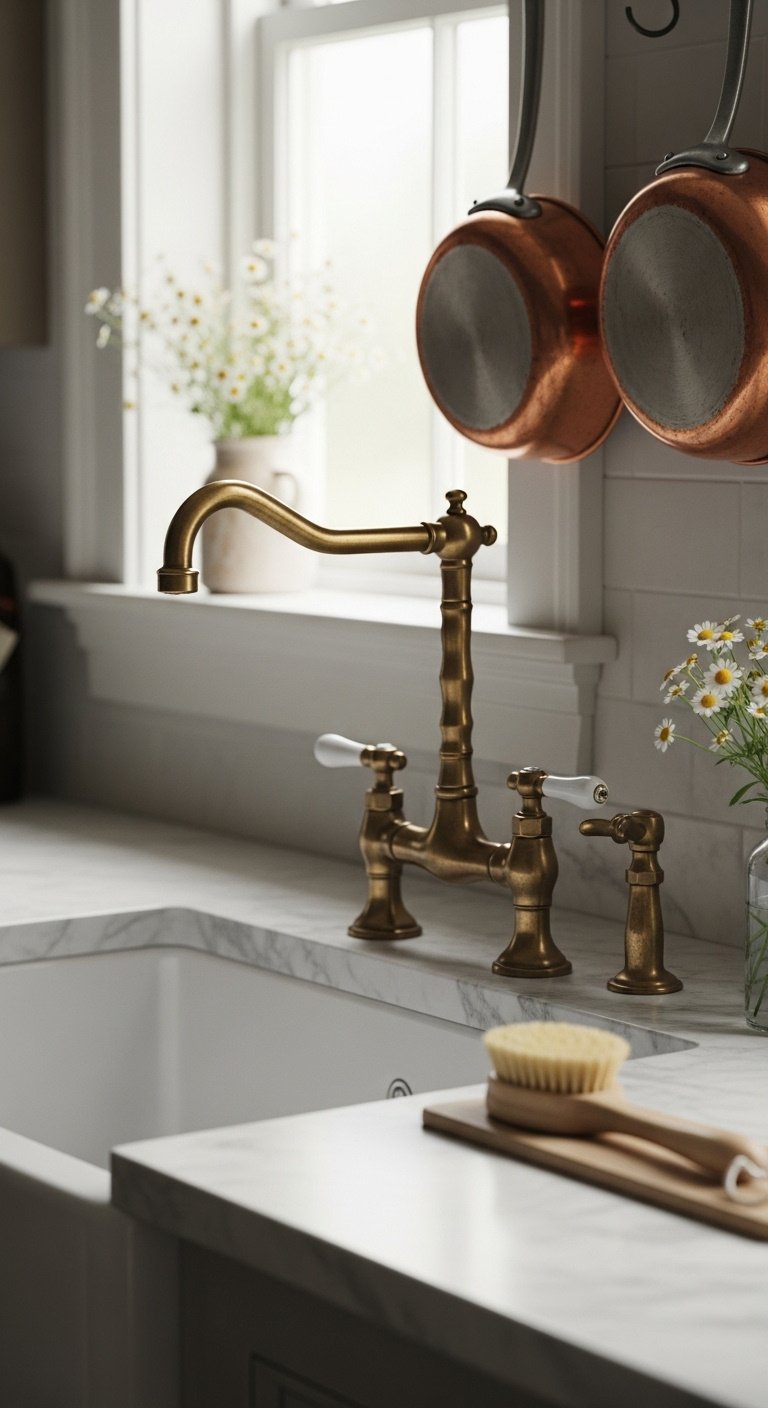
- Materials Needed: A variety of metal finishes (e.g., aged brass, oil-rubbed bronze, polished copper).
- Step-by-Step Directions:
- Choose a Dominant Metal: Select one primary metal for the most prominent hardware, like your cabinet pulls and knobs. Aged brass or oil-rubbed bronze are great choices.
- Add a Secondary Metal: Introduce a second metal for your faucet or lighting fixture.
- Incorporate Accent Metals: Use a third metal for decorative pieces. Hang a collection of copper pots from a rack, display brass utensils in a crock, or use a wrought iron paper towel holder.
- The key is to spread the different finishes around the room to create a balanced, intentional look.
Lesson Learned: To keep the look cohesive, try to stick to either all warm-toned metals (brass, copper, bronze) or all cool-toned metals (chrome, nickel), though cottagecore heavily favors warm tones.
Love this collected look? Save it for design inspiration!
10. Hunt for Thrifty, Distressed Furniture Finds
For true cottagecore authenticity, scour thrift stores and flea markets for a unique piece of distressed furniture. A vintage hutch, a small buffet, or a rustic bookshelf can provide much-needed storage and serve as a beautiful, character-filled accent that makes your kitchen feel truly one-of-a-kind.
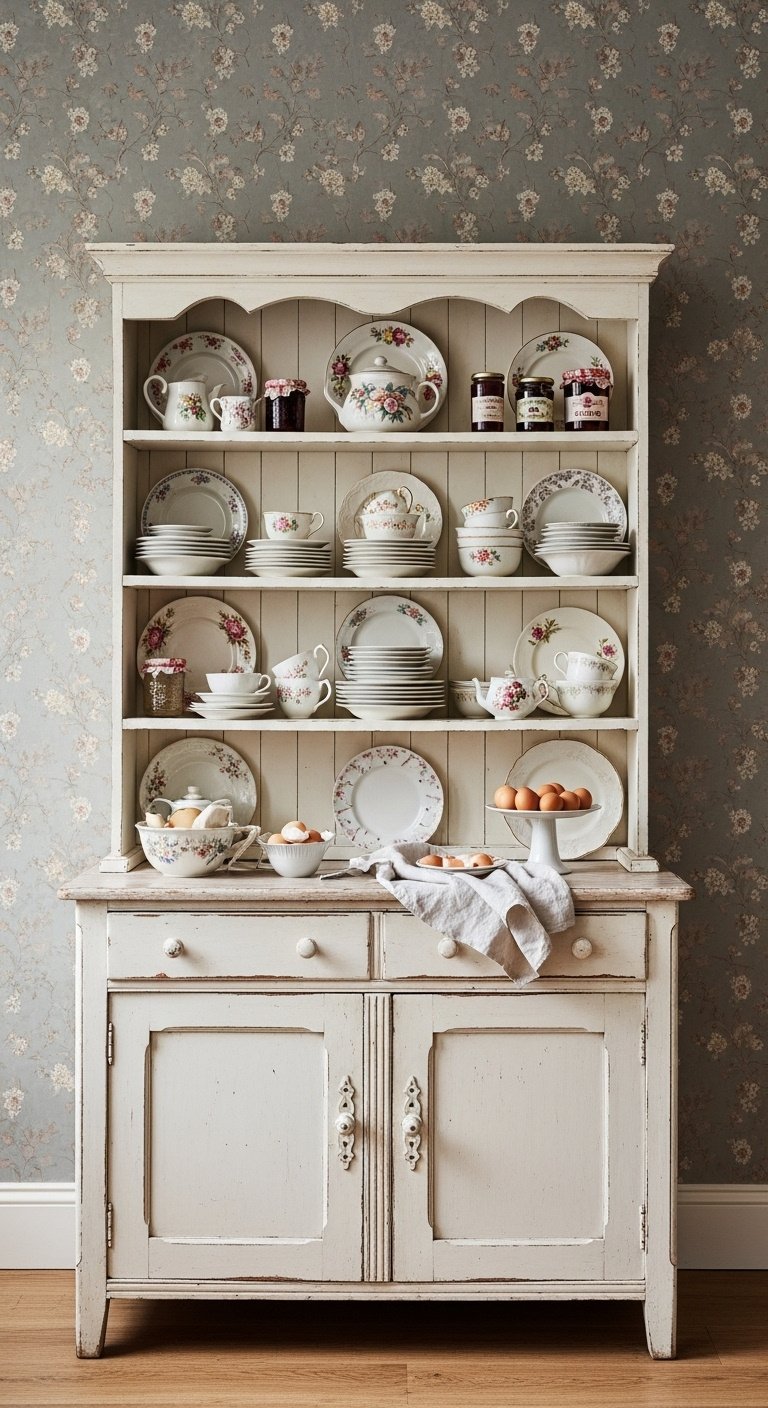
- Materials Needed: A vintage furniture piece (e.g., a small hutch, buffet, or bookshelf), sandpaper, chalk paint (optional), new knobs (optional).
- Step-by-Step Directions:
- Visit local thrift stores, flea markets, and antique shops with an open mind. Look for solid wood pieces with good “bones,” even if the finish is worn.
- Clean the piece thoroughly.
- Embrace the existing distressed look or enhance it by lightly sanding the edges and high-traffic areas to reveal some of the wood underneath the paint.
- For a fresh look, apply a coat of chalk paint in a soft, cottagecore color and distress it yourself after it dries.
- Use the piece as a coffee bar, extra storage for dishes, or a place to display cookbooks and decor.
Pro-Tip: Think outside the box. A small antique dresser can become a charming kitchen island for a small space, or an old bookshelf can serve as a pantry for jars and dry goods.
Start your treasure hunt! Pin this thrifty idea.
11. Use Floral Patterns and Natural Textiles
The final layer of a perfect cottagecore kitchen is softness and pattern, so incorporate natural textiles like linen and cotton with floral or gingham prints. These fabrics, used for curtains, tea towels, tablecloths, and cushions, break up the hard surfaces and infuse the room with romantic, vintage charm.
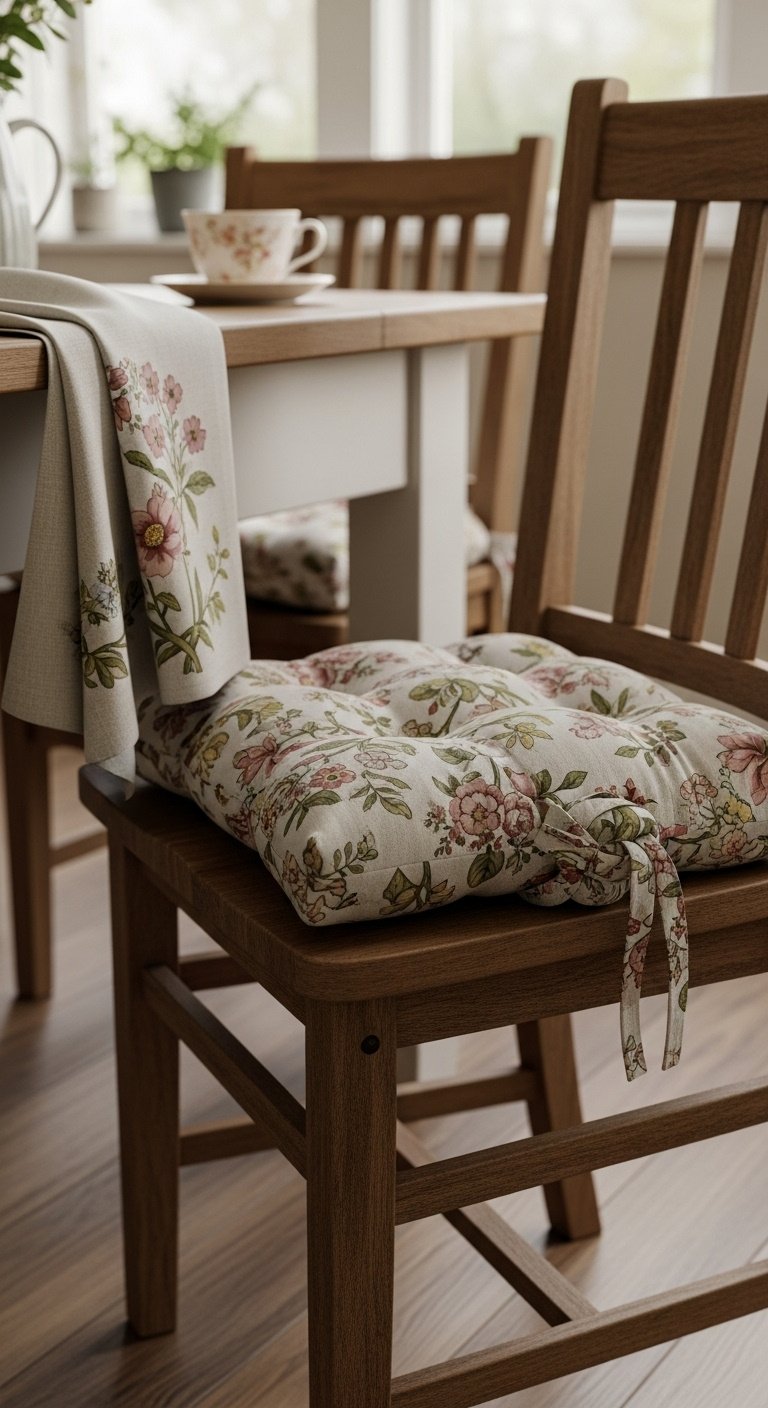
- Materials Needed: A selection of textiles: cafe curtains, a tablecloth or runner, tea towels, and chair cushions.
- Step-by-Step Directions:
- Window Treatments: Install simple cafe curtains in a small floral or gingham print to add privacy without blocking all the natural light.
- Table Linens: Dress your farmhouse table with a linen tablecloth or a simple runner to add softness and protect the surface.
- Accessorize: Drape pretty, patterned tea towels over the oven handle or sink. Add cushions with floral prints to your wooden chairs for comfort and charm.
- Don’t be afraid to mix patterns, but keep them within a similar color family to maintain harmony.
Lesson Learned: The quickest way to change the feel of a kitchen for the season is through textiles. Swap out for richer, warmer tones in the fall and lighter, brighter florals in the spring.
Add a touch of softness! Save this textile inspiration.
Key Takeaways: Your Quick Guide to a Cottage Core Kitchen
Feeling inspired? Here’s a quick summary of the most important concepts to remember as you create your cozy kitchen retreat.
- Focus on a Natural Palette: Start with soft, earthy colors like sage green, creamy white, and muted blues to create a serene backdrop.
- Embrace Wood: Incorporate wood tones through butcher block counters, reclaimed open shelving, or a central farmhouse table to add warmth and character.
- Layer with Textiles & Patterns: Soften the space with natural fabrics like linen and cotton in floral or gingham patterns for curtains, sink skirts, and tea towels.
- Decorate with Intention: Use woven baskets for storage, display fresh herbs and flowers, and hunt for unique, vintage finds that tell a story.
- Create Cozy Lighting: Layer multiple light sources, including small countertop lamps and vintage-style pendants with warm bulbs, to create an inviting ambiance.
People Also Ask About Cottage Core Kitchens
What is the difference between cottagecore and farmhouse kitchens?
While both styles love rustic elements, farmhouse kitchens often lean towards clean lines, neutral colors (black, white, gray), and practicality. Cottagecore is more whimsical and romantic, embracing softer, earthy colors, mismatched vintage pieces, delicate floral patterns, and a more “lived-in,” slightly cluttered charm that celebrates nature and nostalgia.
Is cottagecore still in style in 2025?
Absolutely. While the trend peaked in popularity, its core principles of comfort, nostalgia, and a connection to nature are timeless. In 2025, cottagecore is evolving into a more refined and personal style, often blending with modern elements for a look that feels both classic and current. It’s less of a fleeting trend and more of an enduring design ethos.
How can I make my small kitchen more cottagecore?
For a small kitchen, focus on key elements that maximize charm without adding clutter. Use a light color palette to make the space feel bigger. Install vertical open shelving to draw the eye up and display decor. Use charming textiles like a sink skirt or cafe curtain. Finally, incorporate small, impactful details like a windowsill herb garden, vintage-style hardware, and a few pieces of handcrafted pottery.
Final Thoughts
Creating a cottagecore kitchen isn’t about following a rigid set of rules or achieving a picture-perfect space. It’s about crafting a room that feels personal, comforting, and uniquely yours. It’s an invitation to slow down, embrace imperfection, and celebrate the simple beauty in the everyday. By layering natural materials, soft colors, and personal treasures, you can build a kitchen that not only looks beautiful but also feels like a warm, welcoming hug every time you step inside.
Which of these cottagecore ideas are you most excited to try in your own kitchen? Let us know in the comments below
